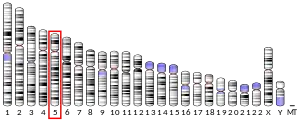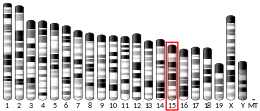NIPBL
Nipped-B-like protein (NIPBL), also known as SCC2 or delangin is a protein that in humans is encoded by the NIPBL gene.[5] NIPBL is required for the association of cohesin with DNA and is the major subunit of the cohesin loading complex.[6] Heterozygous mutations in NIPBL account for an estimated 60% of case of Cornelia de Lange Syndrome.[7]
Structure and Interactions
_in_complex_with_SCC2_N-terminal_domain_(blue)_from_budding_yeast_(Hinshaw_et_al.%252C_2015).png.webp)
NIPBL is a large hook-shaped protein containing HEAT repeats.[8] NIPBL forms a complex with MAU2 (Scc4 in budding yeast) known as the cohesin loading complex.[9] As this name suggests NIPBL and MAU2 are required for the initial association of cohesin with DNA.
Cohesin is thought to mediate enhancer-promoter interactions and generate Topologically associating domains (TADs). As well as mediating cohesion and regulating DNA architecture the cohesin complex is required for DNA repair by homologous recombination. Given that NIPBL is required for cohesin's association with DNA it is thought that NIPBL is also required for all of these processes. Consistently, inactivation of Nipbl results in the loss topologically associating domains[10] and cohesion.[11]
NIPBL binds dynamically to chromatin principally through an association with cohesin.[12] NIPBL’s movement within chromatin is consistent with a mechanism involving hopping between chromosomal cohesin rings. A cohesin-independent function in the regulation of gene expression has also been demonstrated for NIPBL.[13][14]
Clinical significance
Mutations in this gene result in Cornelia de Lange syndrome (CdLS), a disorder characterized by dysmorphic facial features, growth delay, limb reduction defects, and mental retardation.[5] As these mutations are usually heterozygous, CdLS is caused by a reduction in the abundance of Nipbl, not a complete loss. Experiments on cells from patients and mice indicate that the reduction is by less than half.[15] It is not known why a reduction in Nipbl expression results in CdLS.
References
- GRCh38: Ensembl release 89: ENSG00000164190 - Ensembl, May 2017
- GRCm38: Ensembl release 89: ENSMUSG00000022141 - Ensembl, May 2017
- "Human PubMed Reference:". National Center for Biotechnology Information, U.S. National Library of Medicine.
- "Mouse PubMed Reference:". National Center for Biotechnology Information, U.S. National Library of Medicine.
- "Entrez Gene: Nipped-B homolog (Drosophila)".
- Ciosk R, Shirayama M, Shevchenko A, Tanaka T, Toth A, Shevchenko A, Nasmyth K (2000). "Cohesin's binding to chromosomes depends on a separate complex consisting of Scc2 and Scc4 proteins". Molecular Cell. 5 (2): 243–54. doi:10.1016/S1097-2765(00)80420-7. PMID 10882066.
- Rohatgi S, Clark D, Kline AD, Jackson LG, Pie J, Siu V, Ramos FJ, Krantz ID, Deardorff MA (July 2010). "Facial diagnosis of mild and variant CdLS: Insights from a dysmorphologist survey". American Journal of Medical Genetics. Part A. 152A (7): 1641–53. doi:10.1002/ajmg.a.33441. PMC 4133091. PMID 20583156.
- Kikuchi S, Borek DM, Otwinowski Z, Tomchick DR, Yu H (November 2016). "Crystal structure of the cohesin loader Scc2 and insight into cohesinopathy". Proceedings of the National Academy of Sciences of the United States of America. 113 (44): 12444–12449. Bibcode:2016PNAS..11312444K. doi:10.1073/pnas.1611333113. PMC 5098657. PMID 27791135.
- Nasmyth K (October 2011). "Cohesin: a catenase with separate entry and exit gates?". Nature Cell Biology. 13 (10): 1170–7. doi:10.1038/ncb2349. PMID 21968990. S2CID 25382204.
- Schwarzer W, Abdennur N, Goloborodko A, Pekowska A, Fudenberg G, Loe-Mie Y, Fonseca NA, Huber W, Haering C, Mirny L, Spitz F (15 December 2016). "Two independent modes of chromosome organization are revealed by cohesin removal". p. 094185. bioRxiv 10.1101/094185.
- Ciosk R, Shirayama M, Shevchenko A, Tanaka T, Toth A, Shevchenko A, Nasmyth K (February 2000). "Cohesin's binding to chromosomes depends on a separate complex consisting of Scc2 and Scc4 proteins". Molecular Cell. 5 (2): 243–54. doi:10.1016/s1097-2765(00)80420-7. PMID 10882066.
- Rhodes J, Mazza D, Nasmyth K, Uphoff S (2017). "Scc2/Nipbl hops between chromosomal cohesin rings after loading". eLife. 6. doi:10.7554/eLife.30000. PMC 5621834. PMID 28914604.
- Zuin J, Franke V, van Ijcken WF, van der Sloot A, Krantz ID, van der Reijden MI, Nakato R, Lenhard B, Wendt KS (February 2014). "A cohesin-independent role for NIPBL at promoters provides insights in CdLS". PLOS Genetics. 10 (2): e1004153. doi:10.1371/journal.pgen.1004153. PMC 3923681. PMID 24550742.
- van den Berg DL, Azzarelli R, Oishi K, Martynoga B, Urbán N, Dekkers DH, Demmers JA, Guillemot F (January 2017). "Nipbl Interacts with Zfp609 and the Integrator Complex to Regulate Cortical Neuron Migration". Neuron. 93 (2): 348–361. doi:10.1016/j.neuron.2016.11.047. PMC 5263256. PMID 28041881.
- Kawauchi S, Calof AL, Santos R, Lopez-Burks ME, Young CM, Hoang MP, Chua A, Lao T, Lechner MS, Daniel JA, Nussenzweig A, Kitzes L, Yokomori K, Hallgrimsson B, Lander AD (September 2009). "Multiple organ system defects and transcriptional dysregulation in the Nipbl(+/-) mouse, a model of Cornelia de Lange Syndrome". PLOS Genetics. 5 (9): e1000650. doi:10.1371/journal.pgen.1000650. PMC 2730539. PMID 19763162.
This article incorporates text from the United States National Library of Medicine, which is in the public domain.




